Som's magnificent image of our first Snow Leopard on day three of our expedition.
Be Sure to Check Out Ladakh Pbase Galleries:
Snow Leopard Expedition to Ladakh, India
Snow Leopard Expedition to Ladakh
October 18 - 28, 2014

One of the typical views inside Hemis National Park, Ladakh.
I remember not so long ago when
sightings of the elusive Ghost of the Mountain or Snow Leopard were limited to
George Schaller and other intrepid zoologists and lucky Himalaya trekkers and
perhaps a handful of observant and lucky (or maybe not so lucky) Himalayan
villagers trekking the high altitudes.
But sometime around 2009 or so, trip reports indicating Snow Leopard
sightings started to trickle across the internet and some of these made my
screen.
So for about five years now, I
have dreamed of attempting such an ambitious expedition to try to see the mythical
Ghost of the Mountain with my own eyes.
Reading the ever-increasing amounts of successful trip reports posted on
Mammalwatching.com and other sites, and receiving the constant barrage of
Facebook updates from Vikram Singh of Wild World India with images of Snow
Leopards and other amazing Himalayan fauna, I became rather obsessed with doing
my own journey to the region to try for myself.
But one reason after another kept me from realizing my dream to try for
the Snow Leopard, mostly related to time and cash. However that all changed sometime in mid
2013, when I decided to join an expedition to Hemis National Park, located in
the heart of the Ladakh’s Himalayan wilderness.
To make this expedition a reality, I contacted Vikram Singh of Wild World India, who did an amazing job putting all of the travel arrangements together for our group. I absolutely recommend Vikram and WWI for any travel needs in India (we've used them before - See our India Expedition blog here) but Vikram was on of the pioneers in the Snow Leopard expedition market and he knows how to do it right!

(Linked from http://himalayanoutback.com)
The Flight From Delhi to Leh

The flight from Delhi to Leh is one of the world's most epic flights. On a good day, incredible views of the glaciers of the Himalaya (what's left of them....) and the amazing range itself.

So beautiful. We were fortunate to have this kind of day with a half empty flight so we could jump from seat to seat to get better angles.

Receeding glaciers were definitely common in this section of the Himalaya. I cringe at the thought that over 25% of the world's population gets at least some of their water from these and other glaciers in the Himalaya.

Wow....
Hemis National Park is a
relatively newly established national park located about 1.5 hours west of
Leh. Some years back, conservation
groups (The Snow Leopard Conservancy and others) and local tour operators
gained confidence in the ability to market Snow Leopard tracking expeditions
with relatively high potential of success.
It wasn’t too long before many intrepid wildlife enthusiasts were to visit
Ladakh and spread the word. In fact
before too long, the word spread so well that the park was slammed with nearly
five hundred visitors over the years – so many that perhaps too much pressure
was being placed on the resources of the park.
Our own expedition started with a
short trip from Bangkok (our home!) to Delhi, where Cokie and Som had a day to
kill wandering the streets of Old Delhi, experiencing the sights and smells of
this ancient part of the city. I
followed a half day later and met up with them in Delhi for a quick nap before
we headed further to the Himalayan hamlet of Leh, a spectacular town in its own
right. We met up with our team, Jirayu
“Tour” Ekkul, a local Bangkok and ecotour operator with Wild
Encounter Thailand (WET provides epic whale watching excursion that are well worth participating in - see our Whales of Thailand Trip Report), and Pradeep Singh, an Ecotour and tiger safari operator out
of Baratpur, India. Also there were
representatives/spotters working with the Snow Leopard Conservancy. Together we made a formidable team!
An Afternoon in Old Delhi

Som had a great time in Old Delhi taking people pics to her heart's content!
(Check out our Pbase for more of Old Delhi People & Places)

Old Delhi
Five Striped
Palm Squirrel (Funambulus pennantii)

Som got our first mammal of the trip in Old Delhi - Five-striped Palm Squirrel.
Our Team!

Most of our Snow Leopard Expedition crew. A really great group of people made this trip not only possible but a true pleasure. I am glad we had the chance to spend over one week with these folks.
After departing near sea level of
Delhi, and arriving in Leh, we spent time resting and gently trekking mainly
getting used to the extreme altitude (+/- 3800 meters in
Leh). We strolled the streets of the
ancient town and trekked the river zones looking for Ibisbills (of which we
found seven individuals) and Solitary Snipes (nada!). We did get a good glimpse of several other
avian species such as Common Magpies, various Accentors (Robin and Brown). We briefly visited the Thiksey (Thikse) Monastery, which easily ranks high as one of
the more spectacular monasteries in the Tibetan Buddhist regions of central
Asia that I have ever seen. Wow! Leh and its surrounding areas are absolutely
spectacular and are well worth a visit just for the culture and scenery
themselves. Interestingly, the Thai have
completely discovered the region.
Although this was officially the low season, we encountered dozens of
Thai tourists in Leh. None of them were
after Snow Leopards however....
Ibisbill (Ibidorhyncha struthersii)

One of our seven Ibisbills for the trip.

The last time we saw Ibisbills was on our Giant Panda expedition. What is it about Ibisbills and our main target species for life!?

I am not much of a birder at all but I definitely consider the Ibisbill a bird worth targeting.
Thiksey Monastery

Awesome sight. I was very impressed with this and all of the other cliff-side or mountain-top monasteries.

We didn't stroll through but seeing the entirety of it was very nice.

Thiksey Monastery

Thiksey Monastery is about 20 kilometers southeast of town and well worth the trip to see it. And there are some decent birding places along the way.

Thiksey Monastery
Scenes From Leh

Strolling the street markets of Leh

People of Leh

Picking up some last minute supplies in Leh.

Som met these two students coming from their elementary school which consisted of a whopping two students.

The Leh countryside is awesome.
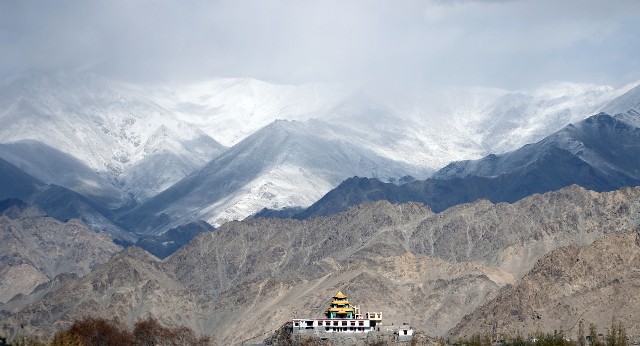
A temple in the Ladakh countryside.

Stok Kambi Mountain is the tallest peak visible from Leh. Spectacular.
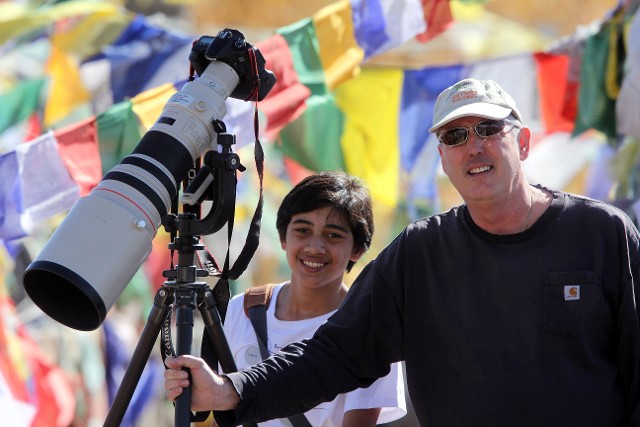
Getting back in to the swing of things...
On our official first day of the
expedition, we had a relatively early start out of Leh eventually reaching the
cliffs aside the spectacular Indus River canyon where we attempted to spot our
first species, the rare and semi-endemic (evidently there is a bit of debate
about whether this species has now been displaced in to Pakistan due to
military development in Ladakh) Ladakh Urial.
We failed to spot any…. I was
hoping this was not a bad omen.
Moreover, I was pretty disappointed with this as the Urial was actually
my number one target – I actually really never thought we’d see a Snow
Leopard….

Searching for Ladakh Urial
So after dipping on the Ladakh
Urial, we continued deeper in to Hemis NP, a spectacular area, worthy of
visiting just for the scenic beauty!
After arriving at the car park at the beginning of the Rumbak Village
trailhead in Hemis, I immediately began to feel the extreme altitude and
vastness of the region. The shear rock
faces and massive mountains were as impressive as they were depressing. How on earth were we ever going to spot a
Snow Leopard, or anything else for that matter, on these batholithic
mountains…? Well we had seven days to
give it a go! I was struck with how barren
it was - virtually no vegetation to speak of covering 95% of the terrain. Where was the base of the trophic pyramid
that could support the purportedly 10-12 adult Snow Leopards that lived in this
area?

The scenic beauty of the entire region was stunning. Here is a typical view from our base in Hemis National Park
After loading our mules with tons
of gear, we trekked for about a couple kilometers with gradual incline when we
spotted our first Himalayan Blue Sheep (Pseudois
nayaur nayaur) , also known as
"leopard food!"), which is a different subspecies than the ones I
spotted on the Tibetan Plateau a couple years earlier (Qinghai Trip Report). A small group of about 10 or so grazed the
hillside directly above the trail. These
individuals looked very different than those I had seen in China. They seemed relatively unafraid of our team,
which was encouraging. We did focus on
capturing them on film for some time, and it was entertaining to see them
express their annoyance with us by purposefully causing rockslides in our
general direction! Our guide, "KC",
encouraged us to get as far away from them as possible at this point.
Himalayan Blue Sheep (Psuedois nayaur nayaur)

Our first herd of of Himalayan Blue Sheep included on young male.
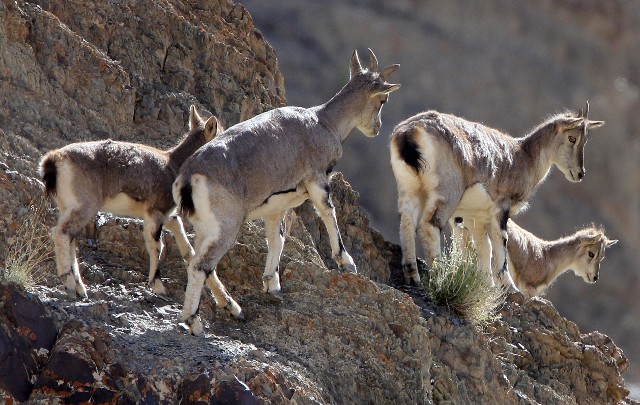
This herd was unafraid and even a bit naughty.

After a bit too much of us, the sheep decided to purposely cause rock slides in our general direction....

Watching them play in the sun in the slopes was great fun.

Even the young were very agile and sure of themselves on the sheer rock faces.

Cute kid!
Shortly after our moment with the
Blue Sheep, our amazing guide KC spotted a Large-eared Pika in the scree
riverbed zone of the canyon. He gave us
a brief viewing before scurrying away to the safety of his den. There seems to be some disagreement in the
taxonomy of the two or three species of the area. Reports routinely list Large-eared and
Royle's Pika, but both species resemble each other quite a bit. An Jon Hall during his expedition one week
prior to ours, listed Nubra Pika.
Large-eared Pika (Ochotona macrotis)

We had our one and only sighting of the Large-eared Pika on our first day's trek to camp near the Winter Camp in Hemis.
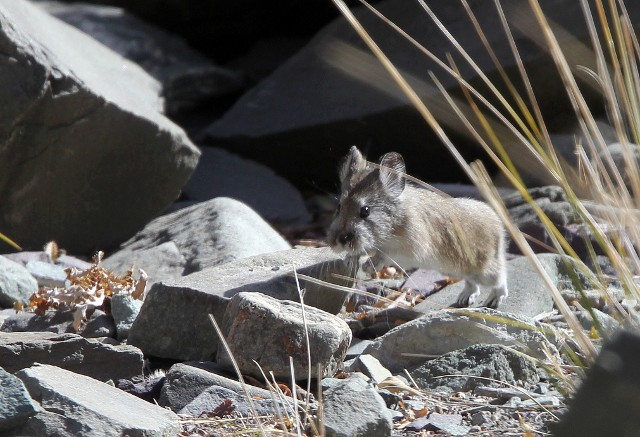
Large-eared Pika at Hemis
The trail heading up to the
“summer camp” (a name given to the further of the two public camping spots –
the Summer Camp is located very close to Rumbak Village which is deeper inside
the core area of the national park) was a long gradual climb through the
spectacular canyons and ravines of the park.
Our condition was very poor evidently as we had to stop and rest every
few dozen meters or so. It was at this
point I realized I was in for a physical challenge for sure on this trip!

The trek to Base Camp in Hemis National Park.

"OK, we've walked about 45 meters. Time for another break!"

Showing a bit of optimism. We were pointing at the place we "planned" on seeing a Snow Leopard in the very near future.
We were directed to use the
Summer Camp as the Winter Camp was still closed for "unknown" reasons. It became very clear the reason was that the
park was building a road directly in to the core area and they were blasting
the hell out of the Winter Camp area with dynamite! With all that disturbance to the region, I
was ever more pessimistic about our chances to see an actual leopard. Eventually we made it up to our camp after a
five or more kilometer trek gradually increase in elevation to about 4200 meters (= 13,780 feet).

Unbelievably they are currently building a road deep in to the core area of the park to Rumbac Village. The river bed will be altered permanently and the increased traffic may have seriously negative consequences on the wildlife in the vicinity. Time will tell but these sorts of projects generally do not result in any positives for the natural ecosystem.
We were all noticeably
exhausted. Even though we rested every
few dozen meters up trail, the altitude and our relative poor condition made
every step a bit of a chore. We arrived
at our camp in the mid afternoon with plenty of time to stake our claim to our
respective tents. Camp was actually
quite nice – we all had our own two-man modern tents as well as a nice
gear-storage tent. There was a kitchen
and crew tent assemblage and a very nice dining tent in which we would spend
many memorable mornings and evenings over the next seven days. Very comfortable. Food at base-camp "Snow Leopard"
was both plentiful and outstanding.
Generally Indian fare, there was enough variety to keep all of our
tastes satisfied and our bellies full.

Our little pack mules. They got the job done though!
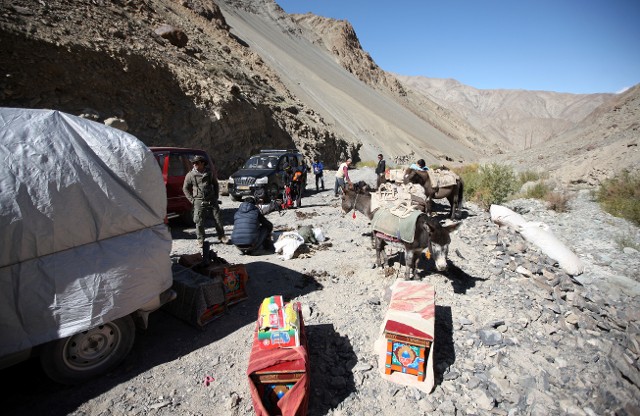
For now, the only way to get stuff to the core area is by mule.
Basecamp Snow Leopard

Base Camp Snow Leopard! Situated at the mouth of Rumbac Valley. It ended up being an outstanding vantage point for spotting the cats!

Cokie contemplating how to build his next city....(Archaeologists in the future will no doubt dig up the ruins of the countless miniature cities Cokie has constructed over the years...)
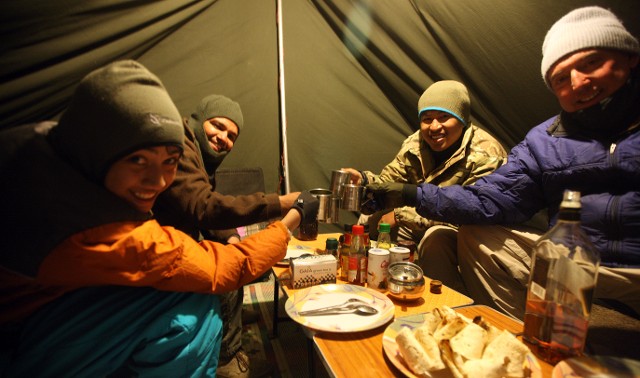
The dining tent was a great place to hang out. In the evenings and early mornings, the heat is on and life is good!

Food was tasty and plentiful with a varied menu.
As our trek was in late October,
days were oppressively sunny and even warm at times, but nights were very cold
reaching in to the high teens to low twenties below zero. We were
all well equipped for the climatic extremes but it had been so long since any
of the Smith’s had experienced such low temperatures, we were all a bit caught
by surprise. It was dang cold!!!! We spent the afternoon acclimatizing to our
new environs while our spotters, KC and Gurmet spent the remainder of the
day scanning the endless slopes in a fruitless attempt to see our target. We had two species under our belts by the end
of day on and that was a great start!
Day two started relatively easily
with a morning scan in the general vicinity of our camp. Again, with the exception of some very
distant Blue Sheep, nothing was spotted.
We then trekked as a group toward the valley leading to Kandala Pass,
stopping periodically to scan the slopes and immense rock faces of the area...again
with no luck. I whispered to Som, “I
will be surprised if we make one sighting of a leopard in this endlessly
mountainous area…” She agreed, but we
tried not to let pessimism envelope us – Hemis was such a strikingly beautiful
place, and it was great to simply be there.
And we had already seen numerous fresh examples of leopard sign along our walks.
Snow Leopard Sign!
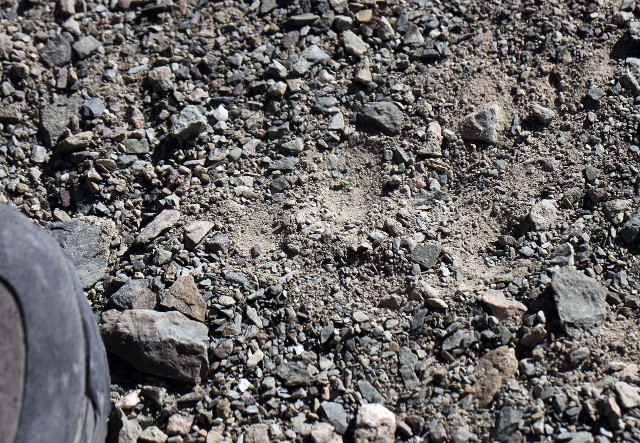
We were encouraged with some relatively fresh Snow Leopard sign on our first day's trek to our base camp.

Obviously a favorite for the leopards of the area, this rock had loads of Snow Leopard hair still attached on the area they would scratch themselves while passing by.

One day old Leopard poo! They were definitely around.

Cokie getting a nose full of the pungent Snow Leopard spray recently released on this rock.
Although day two was a bit slow
with only some bird species added, but we still had lots of time. Sleeping was quite a challenge for most of
us. The altitude and the cold made for
some rough nights. But morning always
seemed to come and familiar sound of KC and Gurmet marching up the hill
near camp to start the search for cats.
I was pretty exhausted this particular morning, having accomplished
little in the way of sleep, I wasn't quite ready for the unexpected screams
coming from the hill by our camp on our third morning in Hemis! "Come!
Come! Leopard!" Initially I thought someone was joking. But the frenzy in the camp made it clear that
it was for real! Someone spotted a
cat!
I really wish I could have some
sort of slow motion video of all of us stumbling out of our sleeping bags,
scampering up the hill, partially clothed, no shoes, totally ill-prepared for
the chill in the hill. The comedy was
most obvious for anyone watching us
sea-level-types struggling to climb the 30 meter long trail to the top of the
hill. Not one of us tourists were able
to make it all the way without stopping to pass out....It was truly pathetic! But after some embarrassing struggles, the
Smith clan made up in time to have about 2 minutes with a splendid Snow Leopard
pacing, rubbing and spraying its way along a distant ridge! Our goal was achieved and he had it! Unfortunately our camera gear was still down
on the bottom of the hill so we were not able to capture any images of this
amazing cat.
Spirits were very high at this
point. Although there was no images to
prove our victory, we were all so jazzed to have at least seen a Snow
Leopard. A lifetime goal realized. There are few feelings as sweet as those one
feels when a lifetime goal is achieved.
Fantastic. Check!
The rest of the third morning was
spent scanning the same mountain again in an effort to spot the cat again. No luck.
The team decided to walk down the canyon a bit to see if we could spot
it from another vantage point. We were
packing up and getting ready to walk when a Swiss trekker, who just happened to
be passing by on his way to a local wedding, spotted what he thought was a cat
on top of the closer ridge nearer to camp.
Initially our guides were a bit skeptical but I was pretty convinced
that he knew what he was talking about. So
we stopped and focused on the ridgeline for awhile....quite awhile...and just
as we were about to give up, Som (of course) spotted him! Right on the
ridgeline as we hoped!

Scanning the endless hillside terrain.

Cokie getting some well-deserved sack time. This kid can still and has been able to crash anywhere, any time!
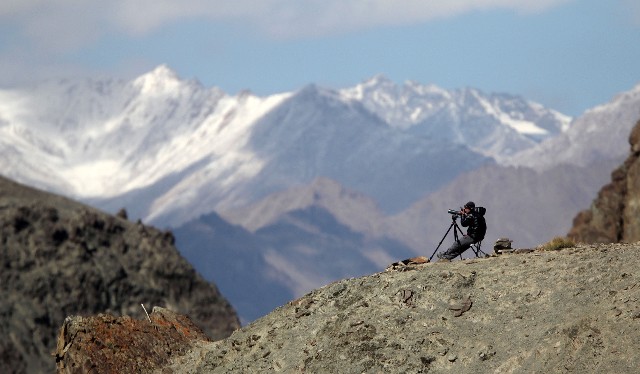
Gurmet watching our napping Snow Leopard very carefully. All was quiet for over two hours, but the second the cat woke up, we knew about it. (On the walkie talkie): "He's awake and moving! Get the cameras ready!"
So for the next several hours, we
spent some quality time with our very own Snow Leopard! Aside from a nap behind a rock for a couple
hours (during which we waited and waited while KC and Gurmet were up on
opposite hills carefully watching him nap), we were incredibly lucky to have a
virtually FULL day sighting of the cat.
Although he was a bit distant, our scopes and lenses gave us amazing
views of this cat carrying about on his daily activities. He was spectacular. Watching this majestic felid pace, crawl,
sand-bathe, spray and stalk prey, was no doubt the wildlife watching high point
of my career. Words simply cannot do
this experience justice.
During
our day with the leopard,
I continually thought of the movie we'd just seen in Bangkok, "The
Secret
Life of Walter Mitty". But I was
committed to actually taking the picture of the cat, unlike Sean Pen! I
was in heaven! A very cold, oxygen poor heaven..... The show lasted
all the way to sunset. Our leopard was quite a showman. I only wish
he could have been a bit closer,
but I am NOT complaining! Moods were
very good in the dining tent this evening!
Snow Leopard (Panthera uncia)

Our first prolonged views of a Snow Leopard. We spent the rest of our day with this individual.

Fresh from his nap, our leopard decides to stretch a bit on the steep slope across from us.

Our leopard working his way down the slope.

The cats are very well camouflaged.
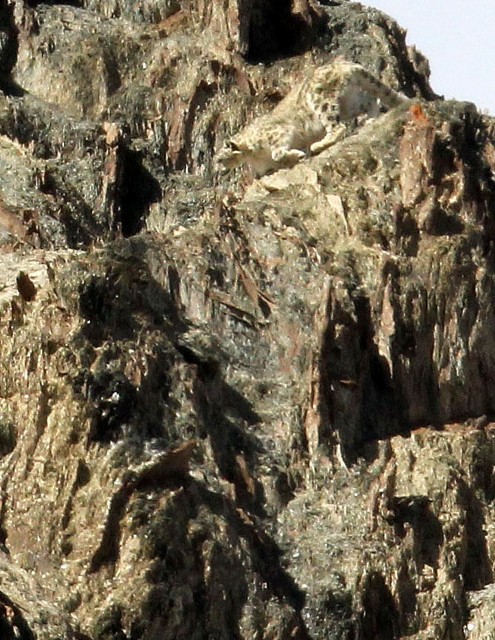
Stunning

Our leopard in different light.
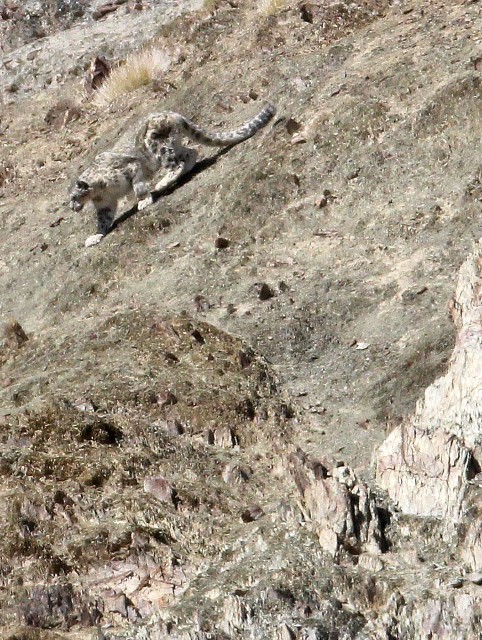
At this point we had no idea what he was up to. He was pacing back and forth across the mountain face for some time.

A cat on a mission.

Hmm...what's over there?
The Hunt that Almost Happened

So our cat (the yellow disk like thing in the lower left) caught a glimpse of the Himalayan Snowcocks in the upper right!

First his legs find solid ground...
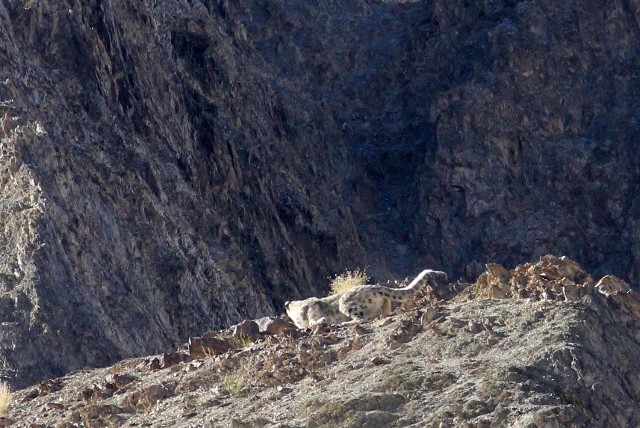
He starts the low profile approach...

Stealthy and deliberate...

Continued approach...

Hunting cat
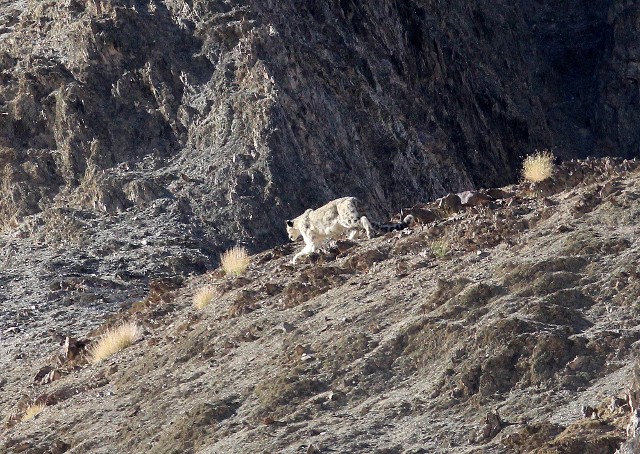
So close....but...

Evidently the Himalayan Snowcocks that were in his view spotted his approach, and he gave up the hunt.
Snow Leopard Sunset

I cannot remember a sunset that was more spectacular than this one.
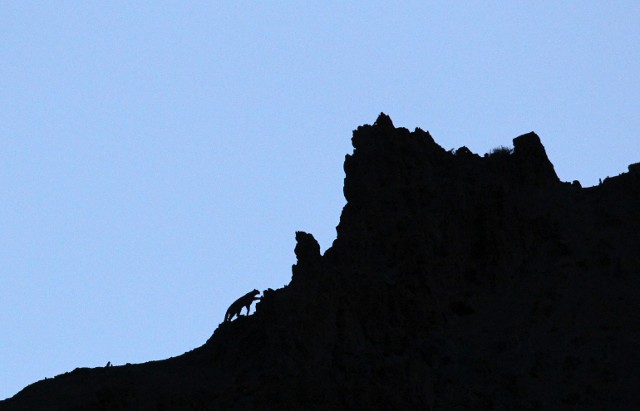
His agile climbing was hypnotic to watch.
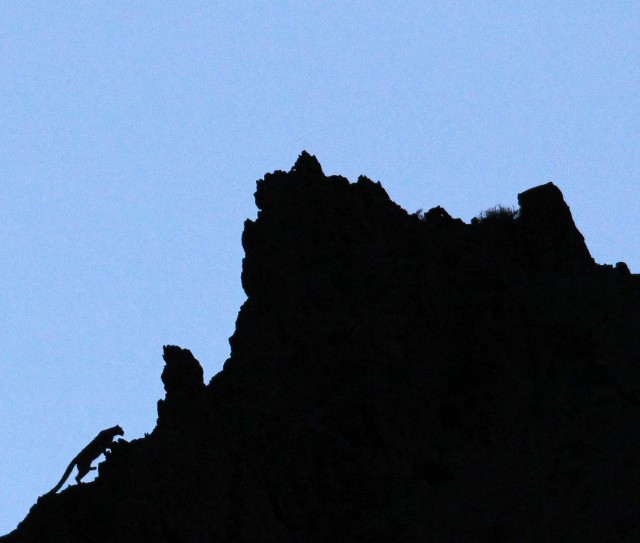
Searching for a place to sleep through the cold night?

Good night

Some happy campers!
Our fourth day started at camp as
usual. No cats this morning. We worked our way back up to a high ridge
near the valley leading to Kandala Pass, and spent the majority of the morning
and early afternoon scanning the slopes.
Aside from a very large and entertaining herd of Blue Sheep, our day was
leopard-less. But it was a great day for
sheep for sure!
Himalayan Blue Sheep

Today was known as "Blue Sheep Day" as we spent the majority of our field time with over forty of them entertaining us.

Many of them were well camouflaged in the rocky slopes.

Three males coming to drink in the freshly thawed stream.

Beautiful!
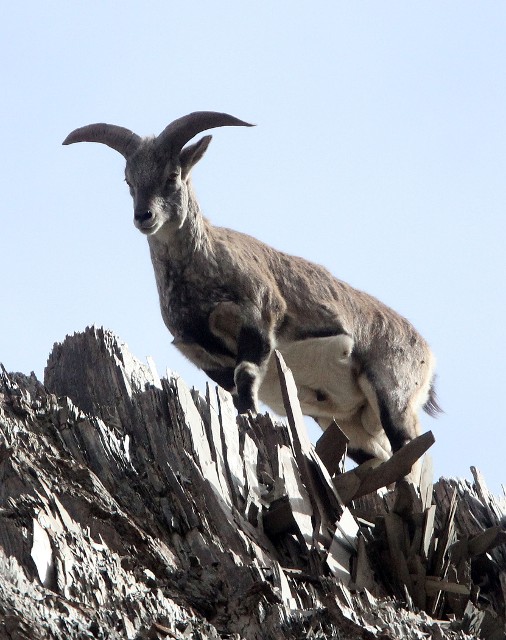
Amazing topography....not a challenge for these sheep!
We were invited to a local
Ladakhi wedding that evening and most of the team enjoyed an awesome time in
Rumbak Village, partying with the bride and groom and their entourage. The bride was from France so the wedding was
bicultural and absolutely spectacular. I
am not much of a wedding person (even though I've had four of my own!!!!), but
I found this one to be one of the best I'd ever seen. What a great night.
The Wedding

Our team enjoying some local Ladakh grub and a fun wedding in Rumbac Village. From the left: "Tour", Gurmet, KC, Stanzin (Owner and Operator of the local ground expedition) & Pradeep Singh. What an awesome group of guys. Honored to have spend a week in the field with them all!

The evening started nice and formal but things did relax as time went by...

Congratulations!
Our fifth day we decided to
travel a bit further down the canyon, with the assumption being that the
leopard would surely not make another appearance in the same location. Evidently this is generally the rule of thumb
- once the cat has been spotted in one location, it's more fruitful to move on
the next day....because that is most likely what the cat is doing. So we spent the day down by the winter camp
inside the Husing Canyon. The area was
outstanding with views of at least five major mountainsides. Leopard spottings are evidently common in the
winter there and in this valley that the famous BBC footage was made a
few years earlier.

Our excellent vantage point in Husing Valley. Excellent views this day, just not of the Ghost of the Mountain...
Our day there was a bit
uneventful however. Aside from some very
fresh sign, all we spotted was a very cute Royle's (?) Pika and some fresh
leopard and fox sign. It was a nice day
on the ridge though - scenery everywhere! Some playful blue sheep here and there but
nothing in the way of a leopard.
Royle's Pica (Ochotona roylei)
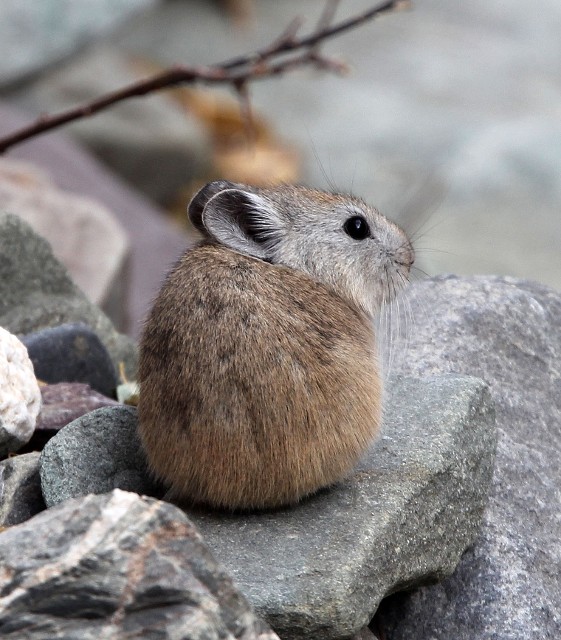
We caught sight of what is most likely a Royle's Pika along the trail down to the Winter Camp.

He didn't seem to mind our presence at all.

Royle's Pika (please feel free to correct if you know better!)
Our walk back to camp was
exhausting. For some reason the same
walk we did a few days earlier with relative ease was an intense challenge for
me and the other members of the team, excluding of course the Ladakhi folks who
walk something like this in their sleep....
Gurmet reached camp well before
us and by the time Cokie and I made it to the camp, he had another leopard in
his scope's field of view! I was so
exhausted but somehow I made it up the hill!
Eventually Pradeep joined and we had outstanding views of not only one
leopard but THREE! We watched (but did
not photograph due to light) a male-female pair and their sub adult cub play on
the far ridge for nearly 45 minutes!
Although we could see them with our naked eyes, the scope afforded us
amazing views of all three of these amazing cats. Although we were all so exhausted, no one
left until it was nearly dark. What a treat.
So we were now up to four leopards!
In five days!
In spite of being immensely
excited and satisfied, I was horribly exhausted. I was barely able to make it
to dinner. Little did I know it, but I
was about to "hit the wall".
It was impossible for me to sleep that night. I was unable to capture enough oxygen to make
it in to sleep. I'd always heard about
people suffering from O2 debt at high elevations, and although I had spent a
fair amount of time at high altitudes, even much higher than Rumbak Camp, I
never experienced what I went through this evening before. It was awful. Eventually my labored breathing woke Cokie
and Som and we tried to get an oxygen tank to help out but somehow one never
made it on the mules. But by early PM
the next day, one had been special-ordered from Leh and after only 20 minutes
inhaling the pure gas, I was restored to near perfect condition! I was amazed in my physical transition. I had a bit of an oxygen headache but I felt
so much better. But I hope to never go
through that again.

I still am amazed how quickly and thoroughly 20 minutes of oxygen turned me around!
Our time in Hemis was truly
outstanding. In my wildest dreams, I
never would have predicted FOUR leopards with at least five sightings over a
six day period. I was truly blown away,
as was everyone else. Our guides and
spotters were very relieved as well - we had far better luck then they anticipated
as well as October is not known for high levels of success. In fact, of the four or so groups that were
there when we were there, only two had sightings. At least two went home empty handed. I can imagine (because I have been there
before!) how that must feel....
The trek back down to the
vehicles was uneventful. We were all so
happy that our time in Hemis had been so fruitful. Tour opted to stay in Rumbak for four more
days to increase his odds at getting a closure image of the Ghost of the
Mountain. The Smith's were happy with
our crappy images on film but our priceless images in our own minds. On the way out of Hemis, we tried fruitlessly
once again to spot some Urial. No
luck...again.... Once back in Leh, it
was so nice to have a real bed and a warm room to stretch out in. So nice to have a hot shower after nearly
seven days of no bathing. Thankfully
sweating was minimal....so no one really reeked...(not counting our feet)...
After some morning activities in
Leh, we decided to try for some more wildlife and another chance at the Urial
up in Ulley Valley. Located about
25-70km from Leh, the Ulley area is outstanding habitat for many different
species. Initially we were becoming discouraged with our attempts to find the
Ladakh Urial....one stop after another with no luck on any slope, but later in
the afternoon it became non-stop sightings.
First three distant male Urial followed by about 10 female and young
male Asiatic Ibexes, followed by a dozen or more very close Ladakh Urial. It was awesome.
Ladakh Urial (Ovis vignei)

Our first Ladakh Urial were quite distant. But after so many hours trying we were happy to get anything at all!
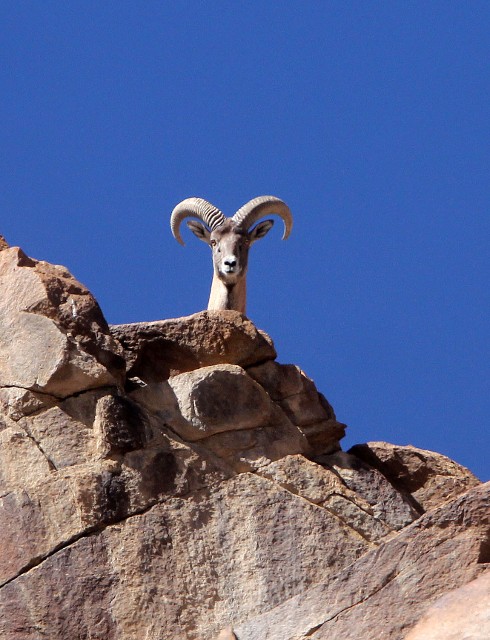
Our second herd gave us a much better view.

A spectacular male came to the edge to see what we were up to.
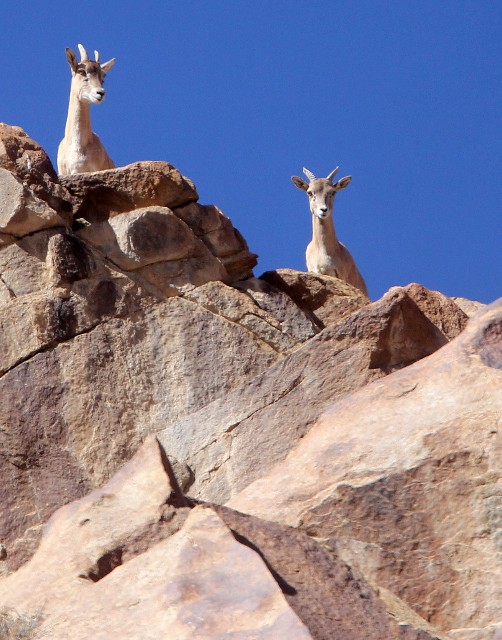
Some young ones came to see as well...

An adult male stretching away after a nap...
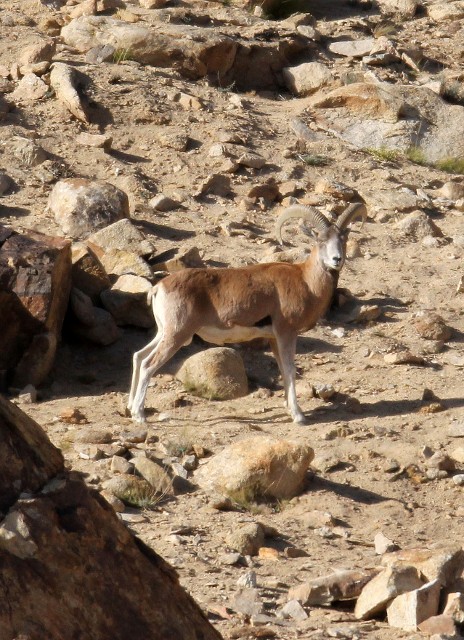
Ladakh Urial

A spectacular male Urial.

Ladakh Urial
Asiatic Ibex (Capra sibirica)

We were pleasantly surprised to find a small female herd of Asiatic Ibex while searching for our Urial.

Asiatic Ibex seen in the Ulley Valley area.
But perhaps the most surprising
sighting of the day was made by me. The
only problem was I was a bit shy about announcing it. I spotted what I thought
was a sleeping Snow Leopard on the hill opposite us, but I was unsure if it was
a leopard or simply a shiny yellow bush.
But after KC confirmed it, we had leopard number FIVE! Truly remarkable. We had our fifth leopard. He did stir a bit for a brief show but mostly
this leopard slept his day away. Over the next several hours, we would search
for other species while periodically looking in his direction to see what he
was up to. Spectacular.

My Snow Leopard spot! Proud of it...
In the late afternoon, on the way
out of Ulley, approaching Leh, we spotted more Ladakh Urial and amazingly, a
pack of SEVEN Tibetan Wolves! They gave
us prolonged and outstanding views. The
thermals in the air there made sharp photography a bit of a challenge but we
were able to capture images of every member of the pack, which consisted of two
blackish, more typical, wolves and five "blonde" wolves that more
than likely have a bit of DNA from domestic dogs. There is currently a bit of a debate on this
last observation but they were definitely unusual wolves from my
perspective. Wow! What a day.
What an expedition!
Tibetan (Himalayan) Wolf (Canis lupus chanco)

A spectacular Tibetan Wolf spotted in Ulley Valley, Ladakh.

Tibetan Wolf

Five of our wolves were blonde in form, no doubt indicating a mix with domestic dogs perhaps.

Blonde form of Tibetan Wolf

Tibetan Wolf - dark morph.
There are a few select species
that a wildlife-watcher such as myself keeps high on the crown of our wish
list. These are species that we only dream of seeing and deep inside actually,
more than likely, realize we may never see.
Such species for me over the years included, of course, Snow Leopards,
Giant Panda, Lowland Gorilla, Babirusa, Clouded Leopards, Tibetan Wolves and
many more. All of these species are ones
we've spent time with by now, so my bucket list is smaller I suppose (although
actually it is simply being filled with other species...) but our Snow Leopard
rank as my all time climax species so far in my career. If my mammal-watching days were to stop now
(please no!), I would leave them satisfied.
Very satisfied.
Some More Leopard Pics!

Snow Leopard #1 giving a good stretch in the morning light!

Our Snow Leopard scanning his domain.

Cryptic Snow Leopard

Our First Snow Leopard

Horrible picture but this is one I got of our Snow Leopard taking a sand bath...

Panthera uncia

Moving on...

Relaxing in the sun...

Snow Leopard

Snow Leopard

If you look hard enough, you can see a Snow Leopard face in this pic.

Something in his territory...
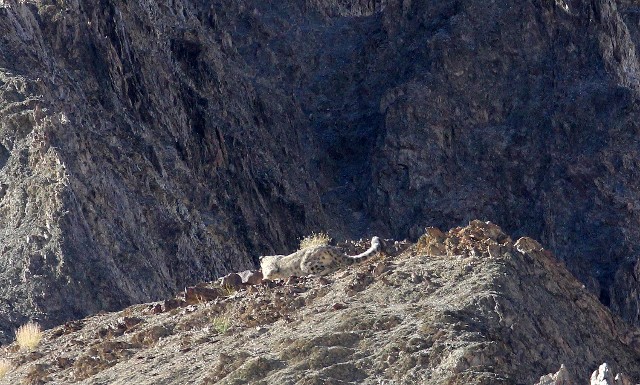
Stalking leopard

Snow Leopard Sunset

Searching

Snow Leopard

I think he is looking at us....
Some Other Critter Pics

Himalayan Blue Sheep on day one.
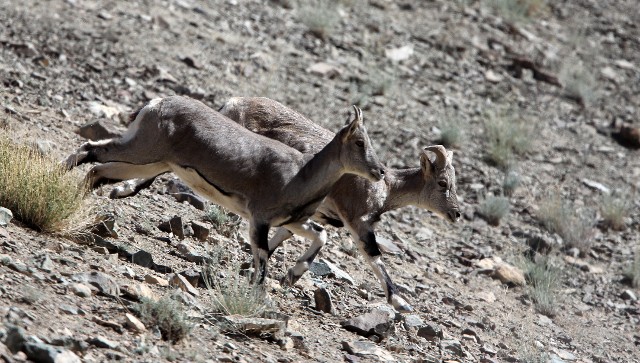
Playful Himalayan Blue Sheep near Winter Camp.

Young male Blue Sheep

Male Blue Sheep

Hemis is actually quite lived-in. Rumbac as well as other villages punctuate the park's interior. There seems to be a peace between the wildlife and the villagers however.

My true #1 target - Ladakh Urial. Great to see it!

Beautiful mature male Urial

Ladakh Urial

Our blonde Tibetan Wolf hybrids

Wolf!

Royle's Pika (I think)
Mammal List Ladakh
- Ward's
(Wroughton's) Wood Mouse (Apodemus wardi)
- Snow Leopard
(Panthera uncia)
- Ladakh Urial
(Ovis vignei)
- Himalayan
Blue Sheep (Pseudois nayaur nayaur)
- Asiatic Ibex
(Capra sibirica)
- Royle's Pika
(Ochotona roylei)
- Large-eared
Pika (Ochotona macrotis)
- Tibetan or
Himalayan Wolf (Canis lupus chanco)
- Five Striped
Palm Squirrel (Funambulus pennantii)
Birds of Ladakh

Brown Accentors were very common near Rumbak

Brown Accentor

Robin Accentors were also common but for some reason I failed to get a decent picture of one!

Red-billed Choughs were common in the mid-elevations in Ladakh.

Yellow-billed or Alpine Choughs were common at the higher elevations of Hemis.

Chukar were extremely common in Hemis. Years of no hunting not only made them plentiful - they were practically fearless.

Chukar!

Chukar in short flight.

Striking birds, Chukar were very well camouflaged.

Another Chukar...

Chukar

OK - last pic of a Chukar!

I have never seen Common Stonechats flock like this....

On one of our treks down the river canyon near Rumbak, we came across several Brown Dippers.
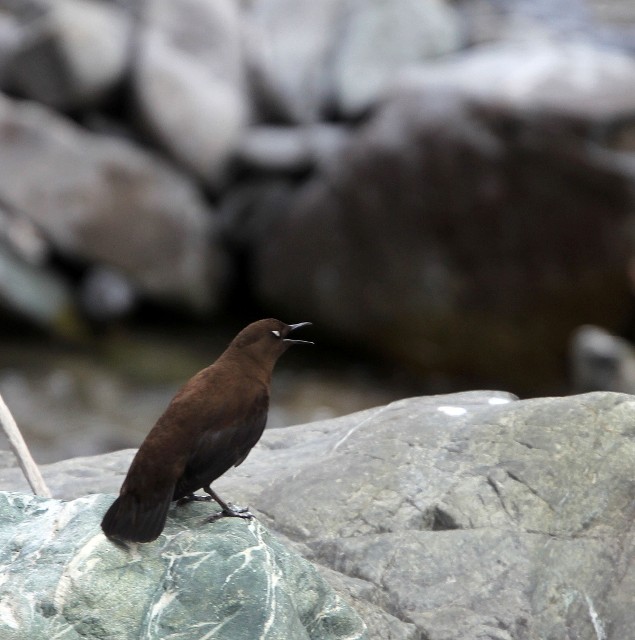
Brown Dipper

We caught a couple in their mating dance...

Flirting Brown Dipper

Golden Eagles were commonly spotted throughout Ladakh.

Golden Eagle

Common Greenshank

Common Greenshank....

Ibisbill

Beautiful pair of Ibisbill near the Dalai Lama's house!

Lunch time!
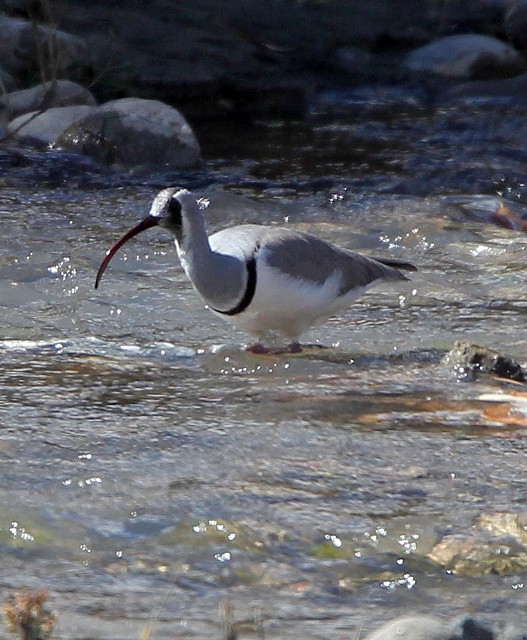
Ibisbill

Our only "close" Lammergeier spotted by Som!

Black-billed Magpies were the most common corvid seen on our trip.

Black-billed Magpie

Hill Pigeons were common in Hemis.

Startled flock of Hill Pigeons

Hill Pigeons

White-winged Redstarts were spotted commonly in Hemis.

White-winged Redstart
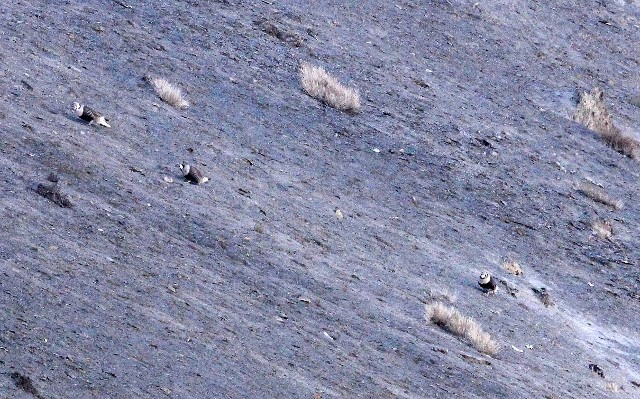
Himalayan Snowcocks were spotted daily but always at the highest elevations. I would loved to have seen them closer.

White Wagtail

White Wagtail
Smaller Critters of Hemis National Park
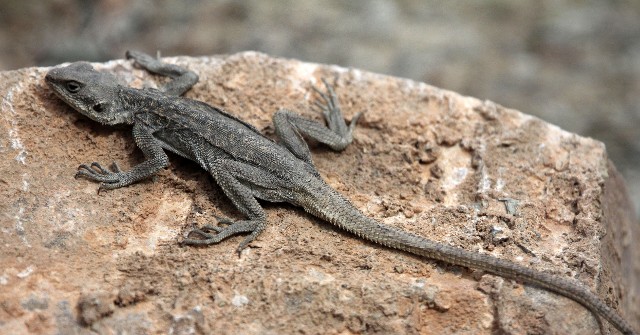
Toad Agama (Phrynocephalus reticulates). I was very surprised to see this sizable lizard at about 4500 meters. He was cold and slow but somehow they survive at these high altitudes.

Toad Agama (Phrynocephalus reticulates)

High altitude Arctiid moth (at least I think it's an Arctiid). I wonder if it is even known to science...

A hardy isopod seems to be at home at 4500 meters...

High elevation Orthopteran!

Wingless Orthopteran!
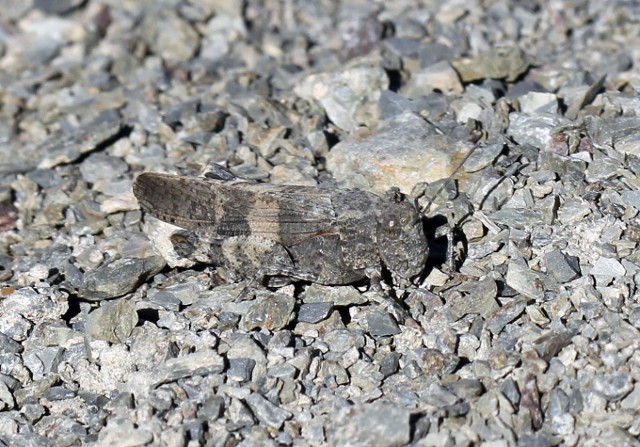
Very cryptic!

Even Arachnids were fairly common at 4500 meters.
Bird List Ladakh
- Tibetan
Snowcock (Tetraogallus tibetanus)
- Himalayan
Snowcock (Tetraogallus himalayensis)
- Chukar
- Mallard
- Common Merganser
- Red-headed
Pochard
- Rock Pigeon
- Hill Pigeon
- Common Coot
- Common
Moorhen
- Common
Greenshank
- Ibisbill
- Golden Eagle
- Lammergeier
- Black Kite
- Common
Kestrel
- Saker Falcon
- Common Raven
- Red-billed
Chough
- Yellow-billed
Chough
- White-throated
Dipper (Cinclus cinclus)
- Brown Dipper
- Common
Stonechat
- White
Wagtail
- Common Myna
- Great Tit
- House
Sparrow
- Robin
Accentor (Prunella ruberculoides)
- Brown
Accentor (Prunella fulvescens)
- White-winged Redstart
- Black-billed Magpie
Other Stuff!

One of Som's better "people" pictures. Wow!

Cokie and his little mule!
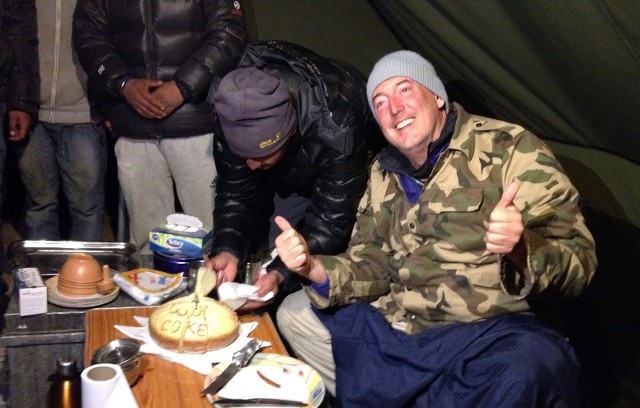
I had a surprise birthday party at 4500 meters! Thanks Som - I love you very much.

52 years old! And I had FOUR Snow Leopards as my gifts!

Cute

Another Old Delhi image...

Old Delhi

Som was being watched in Old Delhi...

Cokie and Som and Old Delhi's Red Fortress...

The beautiful Poplar woodlands of Hemis National Park.

Som documenting plant species for my curriculum project in Hemis.

The stupas near the Thiksey (Thikse) Monastery.

Hemis after a brief dusting of snow...

I was interested in knowing how often avalanches happened in Hemis.
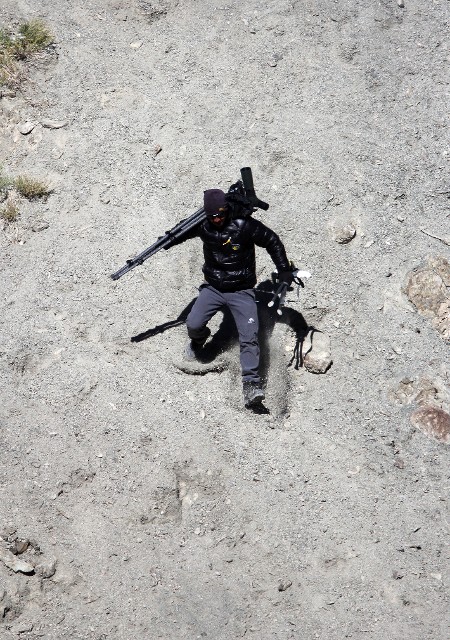
Watching our spotters (in this case Gurmet) scurry up and down the massive hills in Hemis was truly impressive. We routinely referred to them as "supermen!"

The weathering and erosion patterns throughout Hemis were outstanding.

The fall colors in the Willow, Poplar riparian woodlands were perfect!

Himalayan Poplar (Populus ciliata) was the dominant tree species in the area.

Fall foliage in the poplar forests of Hemis.

Pradeep Singh was one of our awesome colleagues on the expedition. Pradeep is a naturalist and owner of a Tiger Safari company.

Just one of the many ridges and vantage points visited during our stay in Hemis.

Father and son are pretty jazzed!
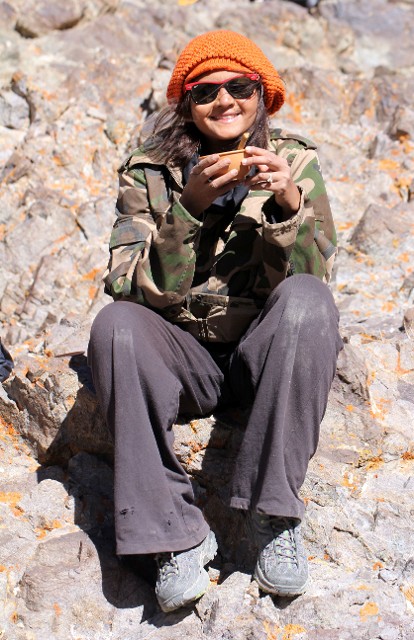
Som enjoying some soup on the trail!

The colors and landforms in Hemis were outstanding.

Our deal was $100 to the first one to spot a leopard. KC got some cash from me the day before, but here Gurmet got some of Tour's cash on day four! (Tour missed the first leopard so this was his first)

The streams would usually thaw by 10AM or so....
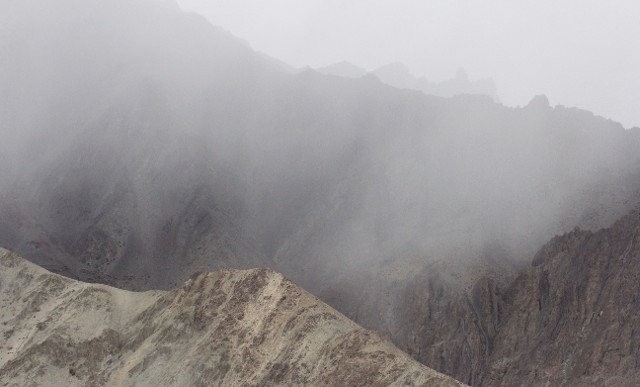
Our only snow during the entire trip. Just a dusting...
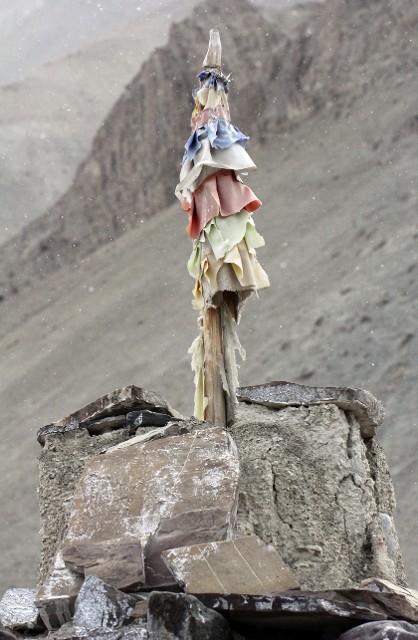
So beautiful...

On our final day in Hemis, we enjoyed a home-cooked meal at one of the homestays in Rumbac Village.

Awesome Ladakhi dumplings

So good...

Som enjoying her soup again.

Mani Stones in Hemis

Kicking back at Base Camp looking at some the pretty impressive iPhone images and videos of the day's amazing Snow Leopard.

Lunch and tea was always portered to our vantage point, even if it was several kilometers away. These guys worked their tails off for us.

Of course Toby and Nyungwe were with us on this expedition!

Waking up Cokie - time to go back to Base Camp!

Cokie taking a breather during one of our treks.

Blue Sheep skull on Mani (Prayer) Stone mound...

OK, which one is the Gatorade....and which one is something you would probably not want to drink??? We have a new rule - NEVER use Gatorade bottles for this purpose!

Cokie's turn to spot a leopard....

My two favorite people!

Som catching some zzzz's and searching for leopards in Husing Valley.

Ephedra kardangensis was common in the Husing Valley but I only noticed it there.

Our view on the flight from Delhi to Leh was outstanding.

So beautiful

We couldn't take our eyes off the scenery.

Stunning

Som earning her keep!

Another beautiful monastery in Ulley.

Unbeatable team!

My little MAN! Oh my goodness!

Hemis is incredibly beautiful.
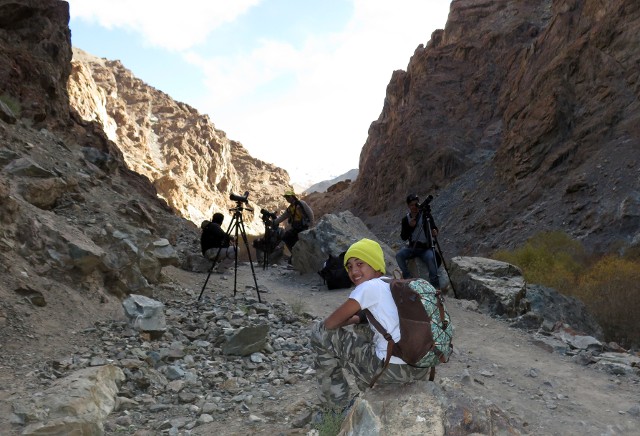
Have you seen any Snow Leopards?
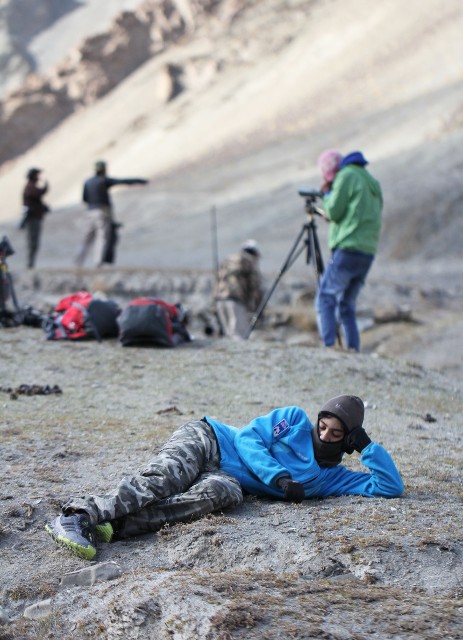
Killing time while dad is talking business...

See if you can spot Cokie in this image. He was generally in the lead during our treks in Hemis.

One of the gates in Rumbac Village.
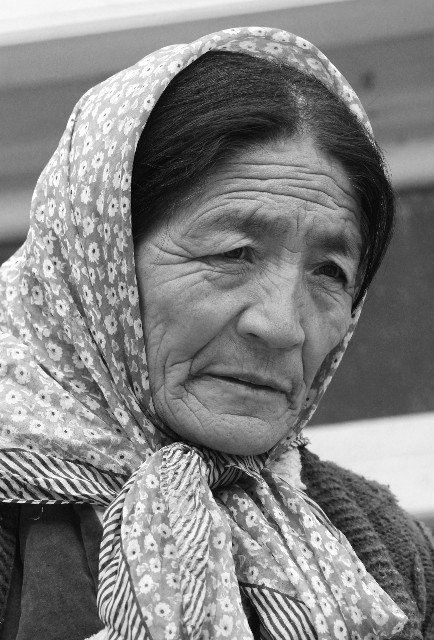
Another beautiful shot in Rumbac by Som.

Our awesome team! At the time of this group photo, we had only four leopards under our belts...

We will never forget our expedition in to the country of the Snow Leopard.

The Ghost of the Mountains
Be Sure to Check Out Ladakh Pbase Galleries:
Snow Leopard Expedition to Ladakh, India
Here are some useful links for studies conducted in Hemis:
http://dlc.dlib.indiana.edu/dlc/bitstream/handle/10535/3567/MPhil_Thesis.pdf?sequence=1
http://snowleopardconservancy.org/wp-content/uploads/2013/07/Jackson_Camera_trap_WSB-1.pdf
http://www.snowleopardnetwork.org/GrantFinalReports/DevkotaFinal09.pdf
http://web.stanford.edu/class/msande75si/sl1.pdf
